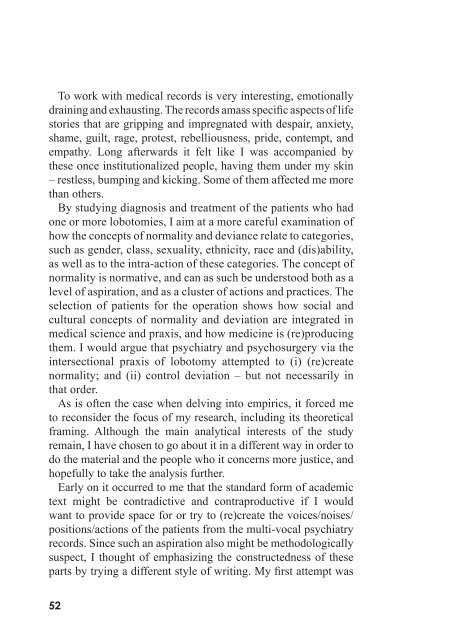Thinking with Bevereley Skeggs - Stockholms universitet
Thinking with Bevereley Skeggs - Stockholms universitet
Thinking with Bevereley Skeggs - Stockholms universitet
- No tags were found...
You also want an ePaper? Increase the reach of your titles
YUMPU automatically turns print PDFs into web optimized ePapers that Google loves.
To work <strong>with</strong> medical records is very interesting, emotionallydraining and exhausting. The records amass specific aspects of lifestories that are gripping and impregnated <strong>with</strong> despair, anxiety,shame, guilt, rage, protest, rebelliousness, pride, contempt, andempathy. Long afterwards it felt like I was accompanied bythese once institutionalized people, having them under my skin– restless, bumping and kicking. Some of them affected me morethan others.By studying diagnosis and treatment of the patients who hadone or more lobotomies, I aim at a more careful examination ofhow the concepts of normality and deviance relate to categories,such as gender, class, sexuality, ethnicity, race and (dis)ability,as well as to the intra-action of these categories. The concept ofnormality is normative, and can as such be understood both as alevel of aspiration, and as a cluster of actions and practices. Theselection of patients for the operation shows how social andcultural concepts of normality and deviation are integrated inmedical science and praxis, and how medicine is (re)producingthem. I would argue that psychiatry and psychosurgery via theintersectional praxis of lobotomy attempted to (i) (re)createnormality; and (ii) control deviation – but not necessarily inthat order.As is often the case when delving into empirics, it forced meto reconsider the focus of my research, including its theoreticalframing. Although the main analytical interests of the studyremain, I have chosen to go about it in a different way in order todo the material and the people who it concerns more justice, andhopefully to take the analysis further.Early on it occurred to me that the standard form of academictext might be contradictive and contraproductive if I wouldwant to provide space for or try to (re)create the voices/noises/positions/actions of the patients from the multi-vocal psychiatryrecords. Since such an aspiration also might be methodologicallysuspect, I thought of emphasizing the constructedness of theseparts by trying a different style of writing. My first attempt was52
















